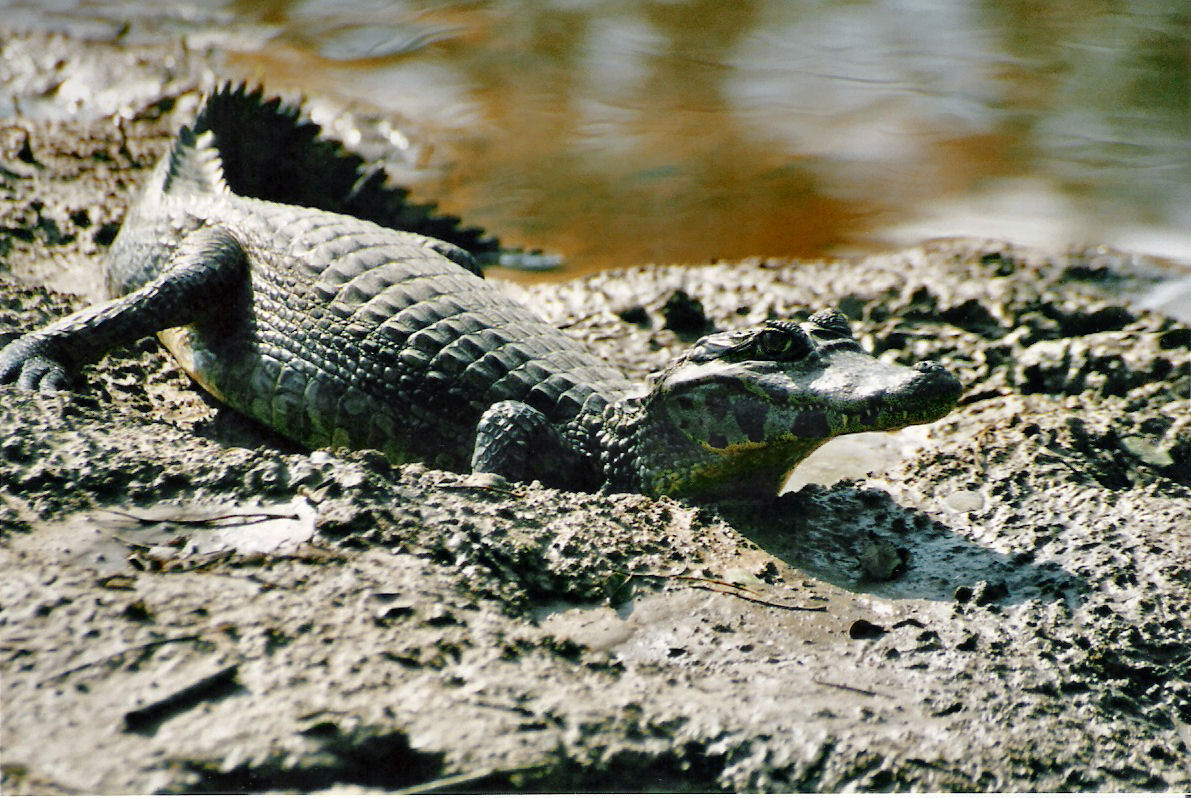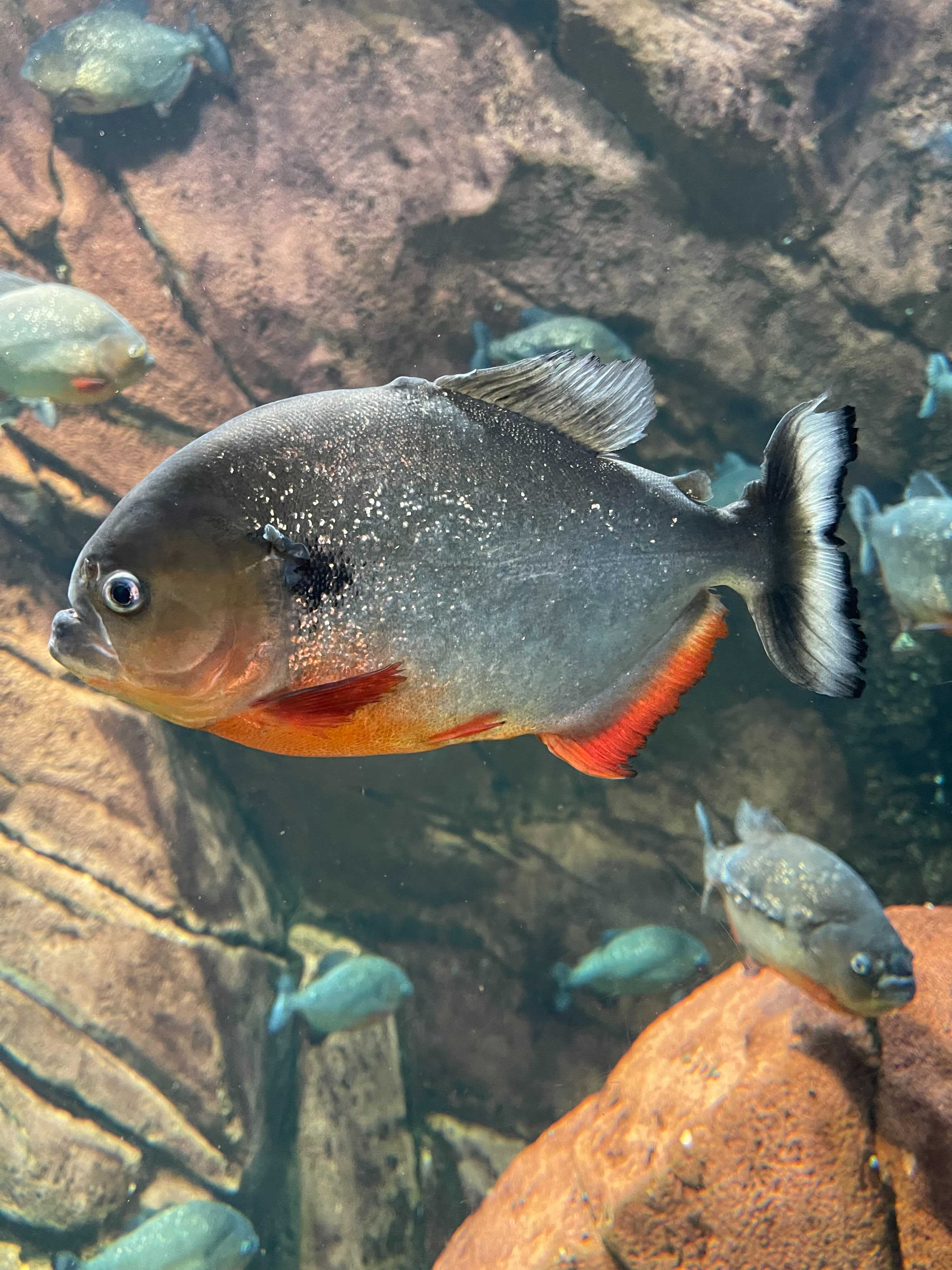|
Caiman Yacare
The yacare caiman (''Caiman yacare''), also known commonly as the jacare caiman, Spanish yacaré, Paraguayan caiman, piranha caiman, red caiman, southern spectacled caiman, ''jacaré'' in Portuguese, and îakaré in Old Tupi, is a species of caiman, a crocodilian in the family Alligatoridae. The species is endemic to Argentina, Bolivia, Brazil, and Paraguay. Brown in color and covered with dark blotches, males grow to a total length (including tail) of and weigh around ; while females grow to long and about . Typical habitats of this caiman include lakes, rivers, and wetlands. Its diet primarily consists of aquatic animals, such as snails, and occasionally land vertebrates. Mating occurs in the rainy season and eggs hatch in March, with young fending for themselves as soon as they hatch. The yacare caiman was hunted heavily for its skin to use for leather in the 1980s, which caused its population to decrease significantly. However, trading restrictions placed since have caused ... [...More Info...] [...Related Items...] OR: [Wikipedia] [Google] [Baidu] |
Caiman (genus)
''Caiman'' is a genus of caimans within the alligatorid subfamily Caimaninae. They inhabit Central and South America. They are relatively small sized crocodilians, with all species reaching lengths of only a couple of meters and weighing on average. Characteristics Caimans are similar to alligators in morphology but differ in having bony plates, known as osteoderms, buried in the skin on the underside. The broad-snouted and spectacled caimans are characterised by having a bony ridge across the bridge of the nose just below the eyes. The yacare caiman is the largest species in the genus, attaining an average adult length of , the spectacled caiman reaches , with the female rather smaller, and the broad-snouted caiman is the smallest, more typically measuring for males and for females. Distribution and habitat This genus is present in Central and South America. The spectacled caiman (''Caiman crocodilus'') occurs in Central America and parts of the northern half of South Ameri ... [...More Info...] [...Related Items...] OR: [Wikipedia] [Google] [Baidu] |
Late Miocene
The Late Miocene (also known as Upper Miocene) is a sub-epoch of the Miocene epoch (geology), Epoch made up of two faunal stage, stages. The Tortonian and Messinian stages comprise the Late Miocene sub-epoch, which lasted from 11.63 Ma (million years ago) to 5.333 Ma. The evolution of life The gibbons (family Hylobatidae) and orangutans (genus ''Pongo'') are the first groups to split from the line leading to the hominins, including humans, then gorillas (genus ''Gorilla''), and finally, chimpanzees and bonobos (genus ''Pan (genus), Pan''). The splitting date between hominin and chimpanzee lineages is placed by some between 4 to 8 million years ago, that is, during the Late Miocene. References External links GeoWhen Database - Late Miocene Miocene, .03 Miocene geochronology, 03 Messinian, * Tortonian, * {{geochronology-stub ... [...More Info...] [...Related Items...] OR: [Wikipedia] [Google] [Baidu] |
Argentina
Argentina (), officially the Argentine Republic ( es, link=no, República Argentina), is a country in the southern half of South America. Argentina covers an area of , making it the second-largest country in South America after Brazil, the fourth-largest country in the Americas, and the eighth-largest country in the world. It shares the bulk of the Southern Cone with Chile to the west, and is also bordered by Bolivia and Paraguay to the north, Brazil to the northeast, Uruguay and the South Atlantic Ocean to the east, and the Drake Passage to the south. Argentina is a federal state subdivided into twenty-three provinces, and one autonomous city, which is the federal capital and largest city of the nation, Buenos Aires. The provinces and the capital have their own constitutions, but exist under a federal system. Argentina claims sovereignty over the Falkland Islands, South Georgia and the South Sandwich Islands, and a part of Antarctica. The earliest recorded human prese ... [...More Info...] [...Related Items...] OR: [Wikipedia] [Google] [Baidu] |
Museum Of Veterinary Anatomy FMVZ USP
The Museum of Veterinary Anatomy (MAV), pt, Museu de Anatomia Veterinária Prof. Dr. Plínio Pinto e Silva, is a museum open to public at the Faculty of Veterinary Medicine and Animal Science (FMVZ) at the University of São Paulo (USP), Brazil. It was named in honor of Professor Plinio Pinto e Silva, veterinarian and member of the São Paulo Veterinary Medicine Academy, a pioneer in obtaining the ''associate professor'' title at the Faculty of Veterinary Medicine of USP. The museum was opened to visitors in 1984 and has a permanent exhibition, studied and curated by teachers, professionals and students of the faculty. Before the museum was opened to visitors, the collection was used by college teachers in their classes. Between 2004 and 2008, the MAV was closed to visitors for the transfer of FMVZ headquarters to USP's college campus (known as ''Cidade Universitária''). Collection The museum has a collection of about 2,000 objects, including several mounted animals, skeleton ... [...More Info...] [...Related Items...] OR: [Wikipedia] [Google] [Baidu] |
Piranha
A piranha or piraña (, , or ; or , ) is one of a number of freshwater fish in the family Serrasalmidae, or the subfamily Serrasalminae within the tetra family, Characidae in order Characiformes. These fish inhabit South American rivers, floodplains, lakes and reservoirs. Although often described as extremely predatory and mainly feeding on fish, their dietary habits vary extensively, and they will also take plant material, leading to their classification as omnivorous. Etymology The name originates from the indigenous Tupi people and their respective Tupi language. It is formed from two words, meaning fish and meaning tooth; the same word is used by Indians to describe a pair of scissors. Another possible derivation is from , probably literally "biting-fish". In the mid 18th century the Portuguese merged the word into . Finally, the word may also come from the combination of meaning fish and meaning cut (which also meant "bad" or "devil" in Tupi-Guarani). Taxonomy an ... [...More Info...] [...Related Items...] OR: [Wikipedia] [Google] [Baidu] |
Osteoderm
Osteoderms are bony deposits forming scales, plates, or other structures based in the dermis. Osteoderms are found in many groups of extant and extinct reptiles and amphibians, including lizards, crocodilians, frogs, temnospondyls (extinct amphibians), various groups of dinosaurs (most notably ankylosaurs and stegosaurians), phytosaurs, aetosaurs, placodonts, and hupehsuchians (marine reptiles with possible ichthyosaur affinities). Osteoderms are uncommon in mammals, although they have occurred in many xenarthrans (armadillos and the extinct glyptodonts and mylodontid and scelidotheriid ground sloths). The heavy, bony osteoderms have evolved independently in many different lineages. The armadillo osteoderm is believed to develop in subcutaneous dermal tissues. These varied structures should be thought of as anatomical analogues, not homologues, and do not necessarily indicate monophyly. The structures are however derived from scutes, common to all classes of amniotes and ... [...More Info...] [...Related Items...] OR: [Wikipedia] [Google] [Baidu] |
National Geographic
''National Geographic'' (formerly the ''National Geographic Magazine'', sometimes branded as NAT GEO) is a popular American monthly magazine published by National Geographic Partners. Known for its photojournalism, it is one of the most widely read magazines of all time. The magazine was founded in 1888 as a scholarly journal, nine months after the establishment of the society, but is now a popular magazine. In 1905, it began including pictures, a style for which it became well-known. Its first color photos appeared in the 1910s. During the Cold War, the magazine committed itself to present a balanced view of the physical and human geography of countries beyond the Iron Curtain. Later, the magazine became outspoken on environmental issues. Since 2019, controlling interest has been held by The Walt Disney Company. Topics of features generally concern geography, history, nature, science, and world culture. The magazine is well known for its distinctive appearance: a thick squa ... [...More Info...] [...Related Items...] OR: [Wikipedia] [Google] [Baidu] |
Snout–vent Length
Snout–vent length (SVL) is a morphometric measurement taken in herpetology from the tip of the snout to the most posterior opening of the cloacal slit (vent)."direct line distance from tip of snout to posterior margin of vent" It is the most common measurement taken in herpetology, being used for all amphibians, lepidosaurs, and crocodilians (for turtles, carapace length (CL) and plastral length (PL) are used instead). The SVL differs depending on whether the animal is struggling or relaxed (if alive), or various other factors if it is a preserved specimen. For fossils, an osteological correlate Osteological correlates are marks on the bones of animals that are made from the causal interactions of the soft-tissue Soft tissue is all the tissue in the body that is not hardened by the processes of ossification or calcification such as bo ... such as precaudal length must be used. When combined with weight and body condition, SVL can help deduce age and sex. Advantages Bec ... [...More Info...] [...Related Items...] OR: [Wikipedia] [Google] [Baidu] |
Specific Name (zoology)
In zoological nomenclature, the specific name (also specific epithet or species epithet) is the second part (the second name) within the scientific name of a species (a binomen). The first part of the name of a species is the name of the genus or the generic name. The rules and regulations governing the giving of a new species name are explained in the article species description. For example, the scientific name for humans is ''Homo sapiens'', which is the species name, consisting of two names: ''Homo'' is the " generic name" (the name of the genus) and ''sapiens'' is the "specific name". Historically, ''specific name'' referred to the combination of what are now called the generic and specific names. Carl Linnaeus, who formalized binomial nomenclature, made explicit distinctions between specific, generic, and trivial names. The generic name was that of the genus, the first in the binomial, the trivial name was the second name in the binomial, and the specific the proper term for ... [...More Info...] [...Related Items...] OR: [Wikipedia] [Google] [Baidu] |
IUCN Red List
The International Union for Conservation of Nature (IUCN) Red List of Threatened Species, also known as the IUCN Red List or Red Data Book, founded in 1964, is the world's most comprehensive inventory of the global conservation status of biological species. It uses a set of precise criteria to evaluate the extinction risk of thousands of species and subspecies. These criteria are relevant to all species and all regions of the world. With its strong scientific base, the IUCN Red List is recognized as the most authoritative guide to the status of biological diversity. A series of Regional Red Lists are produced by countries or organizations, which assess the risk of extinction to species within a political management unit. The aim of the IUCN Red List is to convey the urgency of conservation issues to the public and policy makers, as well as help the international community to reduce species extinction. According to IUCN the formally stated goals of the Red List are to provi ... [...More Info...] [...Related Items...] OR: [Wikipedia] [Google] [Baidu] |
Least-concern Species
A least-concern species is a species that has been categorized by the International Union for Conservation of Nature (IUCN) as evaluated as not being a focus of species conservation because the specific species is still plentiful in the wild. They do not qualify as threatened, near threatened, or (before 2001) conservation dependent. Species cannot be assigned the "Least Concern" category unless they have had their population status evaluated. That is, adequate information is needed to make a direct, or indirect, assessment of its risk of extinction based on its distribution or population status. Evaluation Since 2001 the category has had the abbreviation "LC", following the IUCN 2001 Categories & Criteria (version 3.1). Before 2001 "least concern" was a subcategory of the "Lower Risk" category and assigned the code "LR/lc" or lc. Around 20% of least concern taxa (3261 of 15636) in the IUCN database still use the code "LR/lc", which indicates they have not been re-evaluate ... [...More Info...] [...Related Items...] OR: [Wikipedia] [Google] [Baidu] |

_2.jpg)
_07.jpg)



